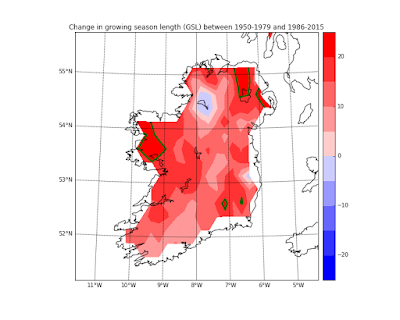Next let's try to run WRF with ERA-Interim data on ORR2.
1) Log on to ORR2
2) Create a directory for these forecasts:
mkdir TESTERA
cd TESTERA/
mkdir DATA
mkdir WPS
mkdir WRF
3) Get ECMWF ERA-Interim data:
3a) Static data doesn't change:
cd DATA/
cp /tmp/CONOR/DATA/ERA_STATIC.grib .
Surface and model-level data need to be downloaded for each forecast time.
Wednesday, 15 February 2017
WRF test case on ORR2
I've recompiled the WPS and WRF programs on ORR2, so you should run the test case again.
1) Log on to ORR2
2) Change into your TESTDIR WPS directory:
cd TESTWRF
cd WPS
3) Clean up your old data:
rm geogrid/*
rm metgrid/*
rm *
4) Run geogrid:
cp /tmp/CONOR/WPS/namelist.wps .
cp /tmp/CONOR/WPS/geogrid.exe .
cp /tmp/CONOR/WPS/geogrid/GEOGRID.TBL geogrid/
./geogrid.exe
When it's finished running, check what has happened:
ls -rthl
You should see this file:
1) Log on to ORR2
2) Change into your TESTDIR WPS directory:
cd TESTWRF
cd WPS
rm geogrid/*
rm metgrid/*
rm *
cp /tmp/CONOR/WPS/namelist.wps .
cp /tmp/CONOR/WPS/geogrid.exe .
cp /tmp/CONOR/WPS/geogrid/GEOGRID.TBL geogrid/
./geogrid.exe
When it's finished running, check what has happened:
ls -rthl
You should see this file:
Friday, 6 January 2017
Giant Rhubarb
Gunnera tinctoria is a large herbaceous plant that forms dense colonies that shade out and suppress native vegetation. This species is a vigorous seeder, and birds facilitate its spread. Its ability to reproduce rhizomatically is yet another reason for its invasive nature. Intense effort is required to control this species (Global Invasive Species database).
Climate Connection?
- What's the best way to investigate the link between Gunnera distribution and GSL/SGS/EGS?
- Associate Gunnera locations with GSL grid. Plot $\Delta$GSL Versus Gunnera density?
- What other climate variables should I look at? Precip? GDD? Soil T?
Changes to Ireland's Growing Season
Growing Season changes: 1950-1979 Vs 1986-2015
Growing Season Length:
Start of Growing Season:
End of Growing Season:
Is there a link between this and invasive species?
Tuesday, 3 January 2017
Calculate Growing Season
In March 2016, the UK Met Office posted a News Release saying that the growing season during the past 10 years is on average 29 days longer than between 1961-1990.
The WMO/ETCCDI report “Guidelines on Analysis of extremes in a changing climate in support of informed decisions for adaptation” [Klein Tank et al., 2009] defines growing season length as the annual count of days between first span of at least six days where TG (daily mean temperature) > 5ºC and first span in second half of the year of at least six days where TG < 5ºC: Count the annual (1 Jan to 31 Dec in Northern Hemisphere) number of days between the first occurrence of at least six consecutive days where T G > 5ºC and the first occurrence after 1 July of at least six consecutive days where TG < 5ºC.
Gridded TG data area available to download as NetCDF files for E-OBS Version 14.0. Gridded E-OBS climate indices are also available to download as NetCDF files on a regular 0.25 degree grid. These include Annual Growing Season Length (GSL), as define by ETCCDI. Note that GSL is based on E-OBS Version 11, while TG data are from the latest version (V14). Differences in versions are described for v14 here and for older versions here. Visual comparisons of the plots they have produced don’t show any noticeable differences in mean temperatures over Ireland, but if I find differences between my calculated GSL values (v14) and the ECAD GSL values (v11), I should check version differences more closely.
The WMO/ETCCDI report “Guidelines on Analysis of extremes in a changing climate in support of informed decisions for adaptation” [Klein Tank et al., 2009] defines growing season length as the annual count of days between first span of at least six days where TG (daily mean temperature) > 5ºC and first span in second half of the year of at least six days where TG < 5ºC: Count the annual (1 Jan to 31 Dec in Northern Hemisphere) number of days between the first occurrence of at least six consecutive days where T G > 5ºC and the first occurrence after 1 July of at least six consecutive days where TG < 5ºC.
Gridded TG data area available to download as NetCDF files for E-OBS Version 14.0. Gridded E-OBS climate indices are also available to download as NetCDF files on a regular 0.25 degree grid. These include Annual Growing Season Length (GSL), as define by ETCCDI. Note that GSL is based on E-OBS Version 11, while TG data are from the latest version (V14). Differences in versions are described for v14 here and for older versions here. Visual comparisons of the plots they have produced don’t show any noticeable differences in mean temperatures over Ireland, but if I find differences between my calculated GSL values (v14) and the ECAD GSL values (v11), I should check version differences more closely.
The Plan
Subscribe to:
Comments (Atom)


